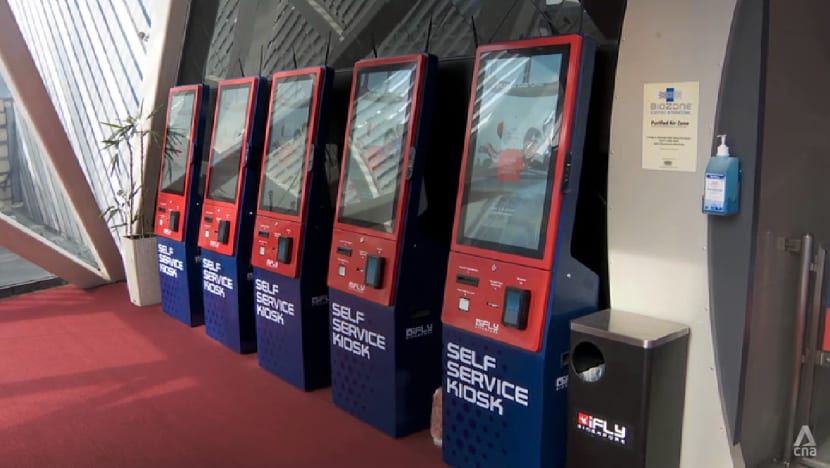Shorter ticket lines, more interactive displays on the cards for Singapore’s tourist attractions
Under the Tourism (Attractions) Industry Digital Plan, operators of local attractions, including small- and medium-size enterprises (SMEs), can get help to adopt digital solutions.

At indoor skydiving attraction iFly Singapore in Sentosa, self-service ticketing kiosks with facial recognition features have been set up to automate guest check-ins and the search and payment process of photos and videos taken during the flight.

This audio is generated by an AI tool.
SINGAPORE: Visitors to Singapore’s tourist attractions could soon get a better experience such as shorter ticket lines and more interactive displays under a new scheme to use more technology to boost the sector.
The Tourism (Attractions) Industry Digital Plan (IDP), developed by the Singapore Tourism Board (STB) and Infocomm Media Development Authority (IMDA), was launched on Tuesday (Nov 7).
Under the plan, operators of local attractions, including small- and medium-size enterprises (SMEs), can get help to adopt digital solutions to drive growth.
The IDP comes on the back of a positive outlook for the global tourism sector, and a strong recovery in Singapore’s international visitor arrivals.
BOOSTING THE ATTRACTIVENESS OF LOCAL ATTRACTIONS
At the launch event, Senior Minister of State for Communications and Information Tan Kiat How said the plan will strengthen the attractiveness of local attractions.
“With the launch of the IDP, we are also trying to embed emerging technologies like artificial intelligence (AI) into the digital solutions. For example, we are looking at generative AI to better help chatbots engage customers and make bespoke recommendations based on their preferences,” he said.
“STB will be providing support for local attractions, including small and medium enterprises to come on board this IDP, and I encourage companies and local attraction players to quickly do so.”
There are more than 60 attractions in Singapore catering to different areas from adventure and rides to museums and heritage.

These attractions face challenges such as rising competition, labour constraints and fast changing travellers’ needs, said experts.
“We face an acute challenge when it comes to manpower constraints, as well as increasing customer demands to have personalised services, which is why we see the pressing need for attractions to digitalise as well to perhaps use the IDP to guide them along this journey,” said Ms Ashlynn Loo, director of attractions, entertainment and tourism concept development at STB.
“Attractions need to innovate and transform and technology can help them streamline operations, improve productivity and enhance the visitor experience,” she told CNA938’s Singapore Today on Tuesday.
“The purpose of this IDP is to provide an easy-to-use, step-by-step guide to help attractions embark on and continue their digitalisation journey.”
The digital plan, which targets customer service and engagement, sales and marketing, and sustainability, is expected to relieve staff of repetitive tasks or having to deal with a lot of data.
The IDP also outlines solutions for companies to adopt at each stage of growth through a roadmap.
For instance, attractions which are at the first stage of their digital capabilities can explore workplace automation and self-service ticketing kiosks.
Attractions that want to grow their digital capabilities can adopt data analytics tools or AI-enabled chatbots, while those aiming to reach a more advanced stage can look at dynamic pricing systems and interactive story-telling capabilities.
USING SELF-SERVICE TICKETING KIOSKS, DATA ANALYTICS
At indoor skydiving attraction iFly Singapore in Sentosa, self-service ticketing kiosks with facial recognition features have been set up to automate guest check-ins and the search and payment process of photos and videos taken during the flight.
iFly Singapore also uses data analytic tools to track and collate visitors’ data such as demographic profiles, footfall and visit time, which are then used for targeted sales strategies and marketing campaigns to increase their visitorship and raise average customer spend.
iFly Singapore founder and chief executive officer Lawrence Koh said: “People used to stay at the reception counter for maybe 10 (to) 15 minutes, just asking, 'what is this waiver form?', 'how to fill it up?' and so on. But right now, most of them will have already signed up online, and they come in just to check in and receive a tag.”
At indoor playground Kiztopia, which has various outlets, a customer relationship management system is used to capture information on customers’ previous purchases, website visits and engagement with marketing e-mails.
This has enabled Kiztopia to use the data to develop targeted sales campaigns for their different customer segments.
It is also investing in the metaverse platform, a concept that may be unfamiliar to many currently.
“People have heard about it, but in reality to really feel it and use it, people are probably lacking in that knowledge,” said Kiztopia founder and chief executive officer Heidi Tian.
“Our target is customers' parents. But we also want to have the kids to play in the metaverse, so there's always a bit of balancing on how much parents are willing for their kids to be exposed to such interactive games.”


















